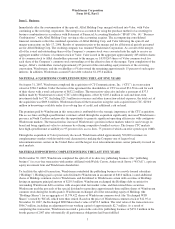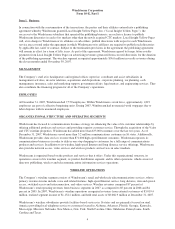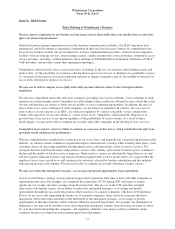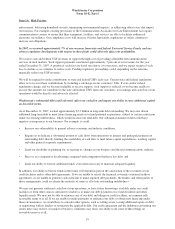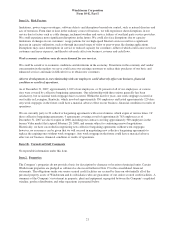Windstream 2007 Annual Report Download - page 59
Download and view the complete annual report
Please find page 59 of the 2007 Windstream annual report below. You can navigate through the pages in the report by either clicking on the pages listed below, or by using the keyword search tool below to find specific information within the annual report.
Windstream Corporation
Form 10-K, Part I
Item 1. Business
greater pricing flexibility, shorter implementation intervals for promotional offerings and deregulation of pricing
for bundled service packages.
• Our regulated Ohio wireline subsidiaries began in 2004 to operate under an alternative regulation plan established
by the Public Utilities Commission (“PUC”). Under this plan, basic service rates have been capped. Non-basic
service rates are subject to limited pricing flexibility. As of August 2006, new rules for alternative regulatory
treatment of basic service have been adopted. Windstream continues to evaluate these new basic service rules but
has not made an election.
• We have three operating subsidiaries in Oklahoma. Our regulated Oklahoma wireline subsidiaries operate under
an alternative regulation plan established by Oklahoma statute. Under this plan, basic service rates can be
increased annually as long as the increase does not exceed $2.00. Legislation was enacted in May 2004 that
regulates Windstream Communications Southwest (approximately 72 percent of access lines in Oklahoma) as a
rural telephone company, thereby allowing this property significant pricing freedom for its basic services and
reducing its costs of regulation.
• In July 2005, our regulated Pennsylvania subsidiary began operating under an alternative regulation plan passed
by the Pennsylvania General Assembly in 2004. Under this plan, we are required to make high-speed Internet
access available for purchase to 100 percent of our customer base by 2013. The plan also limits rate increases to
the GDP-PI less 2 percent, annually. Rates for services the PSC has deemed to be competitive based on
demonstrated availability of like or substitute services offered by alternative service providers are not regulated,
but the public utility commission retains authority over the quality of these services. Revenue neutral rate
rebalancing is also permitted for services not deemed competitive by the PSC.
• Our regulated South Carolina operations are subject to alternative regulation established by South Carolina statute.
Local rates can be adjusted pursuant to an inflation-based index. All other service rates may be increased subject
to a complaint process for abuse of market position. The PSC has determined that any allegations of abuse of
market position will be investigated on a case-by-case basis. Rate increases become effective 14 days after filing.
• We have four operating subsidiaries in Texas. These subsidiaries are subject to alternative regulation established
by Texas statute. Under the statute, basic local rates and intrastate network access rates are capped. In September
2005, the Texas Legislature adopted significant telecommunications reform legislation. This legislation created,
among other provisions, a statewide video franchise for telecommunications carriers, established a framework for
deregulation of the retail telecommunications services offered by incumbent local telecommunications carriers,
created requirements for incumbent local telecommunications carriers to reduce intrastate access charges upon the
deregulation of markets, and directed the Texas Public Utilities Commission (“Texas PUC”) to initiate a study of
the Texas USF.
Inter-carrier Compensation
On October 5, 2007, Verizon filed a complaint with the Ohio PUC alleging that the Company’s intrastate access rates
are excessive and should be reduced to the same levels charged by the largest ILECs in Ohio, or in the alternative, to
the Company’s interstate access rate levels. If the Ohio PUC were to grant Verizon’s request and require the Company
to implement the large ILEC rate structure, the Company would incur a reduction in annual revenues of up to $7.0
million. This estimate assumes the Company would be allowed to implement retail rate increases simultaneously with
the access rate reductions similar to the plan adopted by the PUC for the larger Ohio ILEC access rate reductions. The
Ohio PUC has not acted upon requests by other parties for the Company and other similar sized ILECs in Ohio to
reduce their intrastate access rates.
On December 5, 2007, Verizon filed a complaint with the Kentucky PSC very similar to the complaint filed in Ohio. In
this case, Verizon also alleges that the Company’s intrastate access rates are excessive and should be reduced to the
level currently charged by AT&T (formerly BellSouth). At this time, the Company cannot estimate the financial impact
of any PSC decision due to the various options the PSC could consider if it ruled in Verizon’s favor that would affect
the financial impact of the rate reductions, if any.
13


